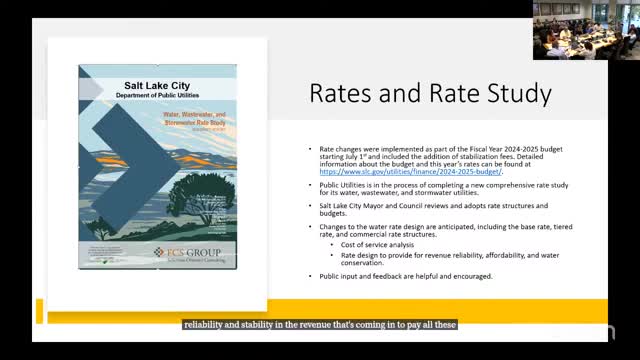Water Rate Study Sparks Debate Over Fairness and Conservation
October 16, 2024 | City Council Work Session, Cottonwood Heights City Council, Cottonwood Heights, Salt Lake County, Utah
This article was created by AI summarizing key points discussed. AI makes mistakes, so for full details and context, please refer to the video of the full meeting. Please report any errors so we can fix them. Report an error »

In a recent government meeting, officials discussed the ongoing efforts to finalize a comprehensive rate study aimed at revising water service fees for residents. The study, which has been in progress for several months, involves a detailed cost of service analysis and is expected to be presented to the city council by late fall or early winter.
Key points from the meeting included the acknowledgment of rising fixed fees for water services, which are anticipated to be higher than last year's levels but lower than the current year's fees that include a stabilization charge. The discussions also highlighted the disparities in water rates between Salt Lake City residents and those in surrounding areas, particularly Cottonwood Heights. Officials explained that Salt Lake City residents pay a property tax to the Metropolitan Water District, which contributes to the infrastructure and supply costs, while residents outside the city do not incur this tax.
Concerns raised by residents regarding these rate differences were addressed, with officials noting that Salt Lake City bears the operational risks associated with the water system, including infrastructure maintenance and regulatory compliance. This risk factor is reflected in the rate calculations.
Additionally, the meeting touched on the city's water conservation policies. Officials emphasized that while pricing strategies are a component of conservation efforts, they are not the sole focus. The city has a Water Conservation Master Plan that includes public education and regulatory measures aimed at reducing excessive water use. For instance, a regulation prohibits service to users consuming more than 200,000 gallons of water per day.
The officials acknowledged the challenges of balancing water pricing with conservation goals, particularly in varying climatic conditions. They noted that past attempts to incentivize reduced water use through pricing adjustments have had mixed results, indicating the complexity of effectively managing water resources in both drought and plentiful years.
Key points from the meeting included the acknowledgment of rising fixed fees for water services, which are anticipated to be higher than last year's levels but lower than the current year's fees that include a stabilization charge. The discussions also highlighted the disparities in water rates between Salt Lake City residents and those in surrounding areas, particularly Cottonwood Heights. Officials explained that Salt Lake City residents pay a property tax to the Metropolitan Water District, which contributes to the infrastructure and supply costs, while residents outside the city do not incur this tax.
Concerns raised by residents regarding these rate differences were addressed, with officials noting that Salt Lake City bears the operational risks associated with the water system, including infrastructure maintenance and regulatory compliance. This risk factor is reflected in the rate calculations.
Additionally, the meeting touched on the city's water conservation policies. Officials emphasized that while pricing strategies are a component of conservation efforts, they are not the sole focus. The city has a Water Conservation Master Plan that includes public education and regulatory measures aimed at reducing excessive water use. For instance, a regulation prohibits service to users consuming more than 200,000 gallons of water per day.
The officials acknowledged the challenges of balancing water pricing with conservation goals, particularly in varying climatic conditions. They noted that past attempts to incentivize reduced water use through pricing adjustments have had mixed results, indicating the complexity of effectively managing water resources in both drought and plentiful years.
View full meeting
This article is based on a recent meeting—watch the full video and explore the complete transcript for deeper insights into the discussion.
View full meeting

